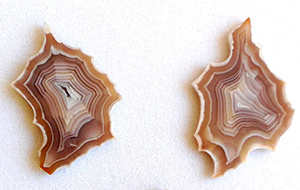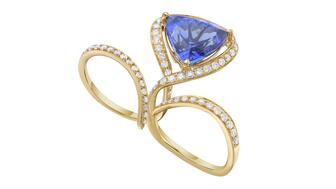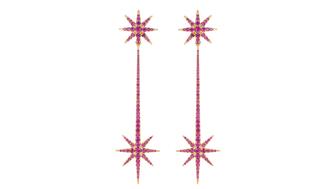Carlos Jose Hernandez and Joshua Zuazo were sentenced to life without the possibility of parole in the 2024 murder of Hussein “Sam” Murray.
Rocks On: Agate’s appealing color show
This gemstone’s varying colors means that every stone is different from the rest, making it extra appealing in a market where everyone is clamoring for a one-of-a-kind piece.

Agate is actually a form of chalcedony, but what sets it apart from the latter is that it forms in layers and, thereby, its color is varied within. A few exceptions to this are moss agate and dendritic agate, which lack the banding but still are considered agates as they contain more than one color.
Having sharp, cleanly defined bands combined with a strong natural coloring can quickly increase an agate’s value, which also can be influenced by factors such as the pattern, condition and origin. It’s also not uncommon for agates to have fractures, which occur during the mining process and also can greatly affect the final price.
Agate’s origins are as varied as its pricing considerations--there’s landscape agate from Brazil, where the color patterns in the stone actually form something like a landscape scene; dendritic agate from India; various colorful agates from around the United States, especially Oregon, Texas, Montana and Arizona; and the many agate localities in Mexico.
Though supply of agate can come sporadically at times, since many sources are mined artisanally and are worked only during local mining seasons, Bill Heher of Rare Earth Mining Co. said agate deposits also can be extensive, which helps make the stone an affordable, available option for jewelry.
And while very large sizes without banding as well as high quality stones are less available than other types, there still remains a fair amount that is not hard to get one’s hands on these days, said Ratan Poddar of gem supplier Shivam Imports.
The hot colors
Among the most desirable pieces of agate are those that show their color over the entire surface without any dead spots, according to the International Gem Society’s online reference library.
And the natural, vivid colors are also a hot ticket. Anything in red, pink, green or yellow is highly desirable on the market, said Mark Lasater of gem dealer The Clam Shell, adding that he attributes it to a movement in recent years by consumers toward natural and untreated gemstones. “Customers always want rare, unique and natural stones,” he
In fact, many of the warmer colors, especially when they’re intense, are highly desired by cutters and collectors, and the best specimens and slabs often go into mineral collections rather than get cut, he said.
Shivam Imports’ Poddar added that he’s noticed an uptick in demand for deeper reddish-orange pieces of agate in the past few months, possibly due to the influence of Marsala being Pantone’s color of the year, resulting in a price increase.
And while there’s plenty of dyed agate available in the colored gemstone market, it’s not so prevalent in fine jewelry, except perhaps in smaller sizes like beads or cabochons, Poddar said.
Most dyed agate comes at a lower cost than the natural material. For example, Lasater said that a gem dealer might charge $5 for a dyed blue Brazilian slab but could expect hundreds for a natural blue slab.
Black tones, however, seem to present a special case. Both men’s and women’s jewelry often are set with dyed black agate because of its similarity to natural onyx so it “will always be a dyed staple,” Rare Earth’s Heher said.
Cameos often can be made from dyed agate as well, which can sell for a fairly high price tag, while dyed tuxedo (black and white) agate, in which the dark part of the stone has taken the dye while the white portion remains natural, offers an interesting and intriguing contrast of colors.
Meanwhile, agate geodes with fine, jewelry-quality quartz crystals are very popular and “have become a staple for designers and goldsmiths worldwide,” Heher said, adding that he believes the trend is far from over and will continue to grow for designers worldwide.
Level playing field
For agate, pricing generally depends on the appearance of the stone, and the sort of inclusions exhibited in it, such as scenes or dendritic trees, also can affect the cost dramatically.
Prices are on the rise right now, and Lasater said he believes there’s one major culprit: the Internet. Just as it has for virtually everything else, the Internet has changed how buyers today are purchasing agate.
In the past most agates, both rough and slabs, were sold at gem shows, where both cutters and collectors would attend and compete for the rare and unique pieces. But since not everyone was able to attend these shows, a segment of buyers were left out of the loop when it came to purchasing agate.
Since the Internet started allowing for auction-style selling and e-commerce of agate, “everyone is on equal footing now, and prices have risen accordingly,” he said.
Rather than a dealer setting a price for agate, these days it goes to the highest bidder. Lasater said this means that good and high quality agates have doubled or tripled in price from what they went for five to 10 years ago.
At the same time, stones from certain older localities, such as Laguna, Coyamito, and Chihuahua in Mexico, as well as Deer Creek fire agate from Arizona, always will garner a higher price if the color and patterns are there.
“In the coming years, high quality, natural agates with great color will only get more expensive and demand will only increase for this type of material. There are too many people chasing a diminishing resource,” Lasater said.
The Latest

Yood will serve alongside Eduard Stefanescu, the sustainability manager for C.Hafner, a precious metals refiner in Germany.

The New Orleans jeweler is also hosting pop-up jewelry boutiques in New York City and Dallas.

How Jewelers of America’s 20 Under 40 are leading to ensure a brighter future for the jewelry industry.

Set in a Tiffany & Co. necklace, it sold for $4.2 million, the highest price and price per carat paid for a Paraíba tourmaline at auction.


The jeweler’s “Deep Freeze” display showcases its iconic jewelry designs frozen in a vintage icebox.

Take luxury gifting to new heights this holiday season with the jeweler’s showstopping 12-carat sphene ring.

Roseco’s 704-page catalog showcases new lab-grown diamonds, findings, tools & more—available in print or interactive digital editions.

This year's theme is “Unveiling the Depths of the Ocean.”

In its annual report, Pinterest noted an increase in searches for brooches, heirloom jewelry, and ‘80s luxury.

Starting Jan. 1, customers can request the service for opal, peridot, and demantoid garnet.

The 111-year-old retailer celebrated the opening of its new location in Salem, New Hampshire, which is its third store in the state.

The new catalog features its most popular chains as well as new styles.

The filmmaker’s personal F.P. Journe “FFC” prototype was the star of Phillips’ recent record-setting watch auction in New York.

The new location in the Design District pays homage to Miami’s Art Deco heritage and its connection to the ocean.

Inflations, tariffs, and politics—including the government shutdown—were among consumers’ top concerns last month.

“Longtime favorite” presenters, as well as first-time speakers, will lead talks and workshops at the annual event in Tucson next year.

Silas Smith of Meridian Metalworks won the challenge with his pendant that blends Australian and American landscapes.

The sale of the 31.68-carat, sunset-hued stone was part of Sotheby’s first series of events and auctions in Abu Dhabi.

Most customers who walk into your store this month have made up their minds. Your job is to validate their choice, Emmanuel Raheb writes.

The collection features characters and motifs from Ukrainian folklore, including an enchanted mirror and a magic egg.

MatrixGold 3.11, the newest version of the jewelry design program, offers more flexibility, precision, and creative control.

The pavilion will be part of the 2026 JA New York Spring show, scheduled for March 15 to 17.

Kadet, a 1994 National Jeweler Retailer Hall of Fame inductee, helped grow the family-owned retailer in the Chicago area and beyond.

Billed as the world’s smallest wearable, Lumia Health’s new smart earrings have a health tracker subtly embedded in the back.

Don’t let those with December birthdays feel blue. Help them celebrate their month with blue zircon, turquoise, and tanzanite.

The new pink sapphire version of the piece dances with its wearer in the brand’s “Icons After Dark” holiday campaign.

























